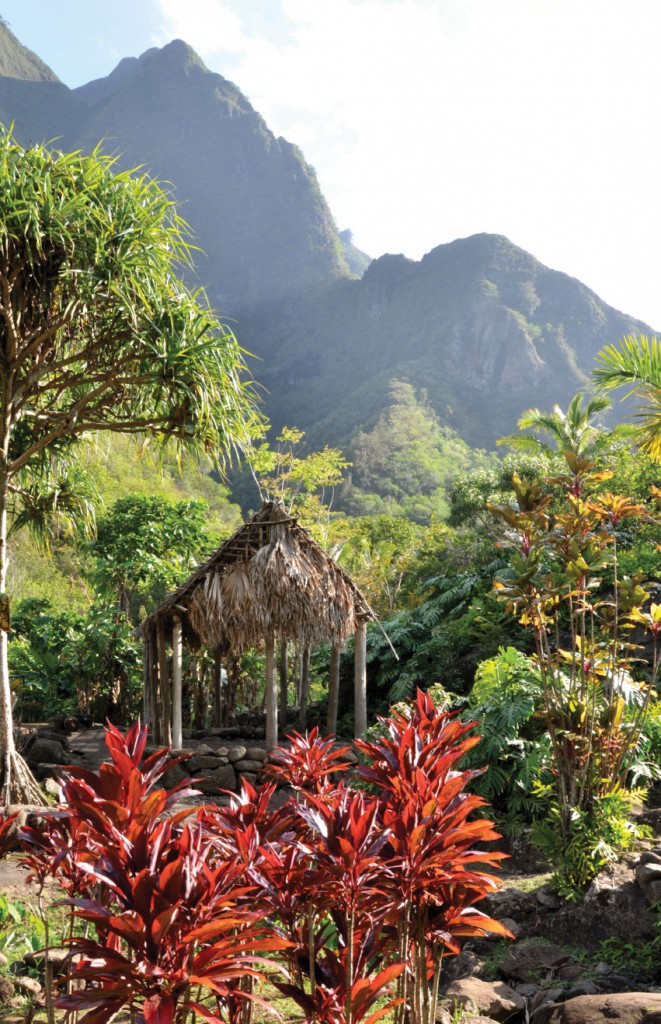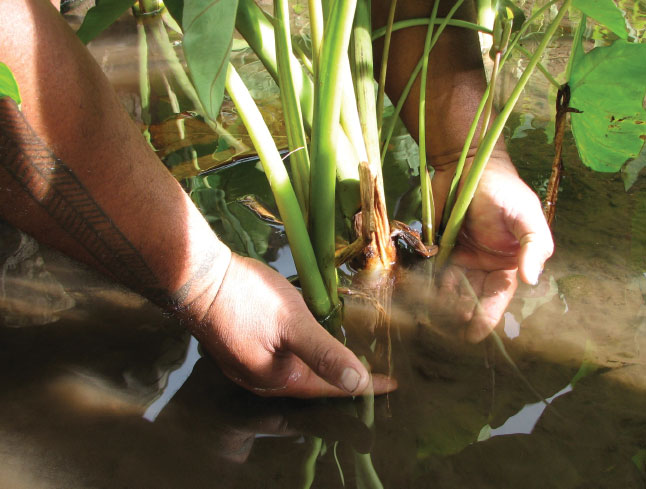Iao Valley
Story by Lois Leinani Whitney
Home to both a County park and a State Monument, ‘Iao Valley is a picturesque recreational area that is delightfully easy to get to, while offering sightseers a chance to step back in time.
The valley walls and waterfall-carved ridges rise high above the popular parks, echoing the many sounds they have heard over the centuries. Oh, the stories they could tell! In recent decades the parks have been the site of countless parties, a favorite destination for swimmers looking to cool off in the river on hot afternoons, and an irresistible attraction for visitors whose ooh’s and aah’s are accompanied by the click of a camera shutter.
Climbing back through history by a little over two centuries, the valley was filled with the sounds of war, as King Kamehameha I invaded the island while Maui’s Chief, Kahekili, was visiting O‘ahu in 1790. It is said that in his attempt to unite the Hawaiian Islands, Kamehameha was accompanied by so many warriors that their canoes filled the entire Bay of Kahului, now Kahului Harbor. Kamehameha brought a powerful weapon to aid his efforts, a Western cannon, as well as two Western advisors who operated the cannon, Issac Davis and John Young.
Although the Chief’s son, Kalanikupule, and other Maui ali‘i (chiefs) fought valiantly they were forced deep into the valley. All the chiefs escaped harm, some scaling the treacherously steep cliffs to find their way to Lahaina, where they fled the island. Many warriors were not so lucky, with so many killed in one day it was described as their bodies causing a “damming of the waters” in the river, hence the name “Kepaniwai.” Maui was defeated, but when Chief Kahekili returned to the island, he refused to abdicate his rule; Kamehameha came back to Maui four years later to take back the island under his control.
Entering the gardens in the lower park, however, one would never know the area’s role in such a decisive battle. A peaceful walking path winds through a miniature bamboo forest, massive stone lions silently guard the entrance to the Chinese pavilion, and waterfalls spill into a serene koi pond near Japanese- style pagodas. Just behind the golden lions at the Chinese gate, look for the Ylang Ylang tree, treasured for its fragrant blossoms used in making some of the finest perfumes in the world. Just pick up a few of the thin white petals that rest in the grass below the tree; their delicate scent will be a lasting reminder of the park’s multicultural delights.
A number of statues and markers throughout the park bring to life other notable figures and events in Maui’s history, especially the many people that immigrated here to work on the sugar cane plantations, bringing with them their language, traditions, values and even food – all of which have become an integral part of the melting pot of island life.
Daily life for the island’s first inhabitants centered around a simple yet very complex staple food: kalo. Kalo, or taro as commonly known, is the starchy root pounded to make poi. The early Hawaiians cooked the kalo then pounded the root on a long wooden poi board, thinned the paste with water and served the fragrant poi in a smooth wooden calabash to be eaten with the fingers. The poi served at a commercial lu-’au may lack the fresh flavor of hand-pounded poi, but it gives an idea of the food that was so important to Hawaiians, that it is associated with the very land it grows in. The word for land, ‘a-ina, is based on the word ‘a-i, “to eat.” Caring for the land was like caring for your own body- you take care of it and it will take care of you.
A few hard-working and dedicated groups ma-lama or care for the stream-fed taro patches at the upper State park. At one time, the four rivers of the West Maui mountains- Na Wai Eha- – watered countless acres of taro from the upper reaches of ‘Iao Valley down to the sea. The shimmering afternoon light on the ponds is a reminder of the tranquility that returned even after the ravages of war took their toll.

The taro remains a link to the ancestors who first inhabited the pristine island, to the highest-ranking ali‘i who were buried in secrecy amongst the valley walls, and to the native Hawaiians who were forbidden to speak their own language in public or at school after their beloved Queen Lili‘uokalani was overthrown by American annexationists. The Hawaiian language is now entering a renaissance period, with immersion schools educating preschoolers through high school, and college, graduate and post-graduate programs focusing on cultural studies.
And through many generations, the silvery waterfalls off the steep cliffs have brought life to the heart-shaped leaves of the kalo, as the echoes in the valley returned from war to the laughter of children enjoying a golden moment in the sun at ‘Iao.
• The landmark ‘Iao Needle is actually a rocky spire that rises 2,250 ft. above the valley floor.
• The recreational area is located off Route 30, just 7 miles from Kahului Airport and a scant 3 miles out of historic Wailuku town.
• Kepaniwai Park is a cool spot for a picnic, with covered picnic shelters, shaded benches and grassy areas to choose from.
• Lots of ponds with fish, a “secret” bamboo forest and easy, paved trails make this a fun stop for children.
• Plant-lovers and history buffs will enjoy the abundance of Hawaiian flora, cultural architecture and historical markers.
• Parking is free at Kepaniwai Park (first left after the bridge); there is a $5 parking fee per vehicle at the ‘Iao Valley State Monument at the top of the road. Hawai‘i residents with ID may park for free.
